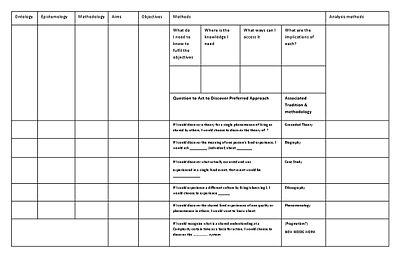Doctor of Philosophy/Thesis structure
Structuring and Writing the Research Thesis (100,000 words)
By Dr Mary Walsh

Research Question
editMain Argument
- ...
- ...
- ...
- The thesis offers a more complete understanding of these key issues and possible alternatives.
Chapter 1: Introduction (5000w)
edit- Introductory paragraphs - What the thesis is about…Where it seeks to make a contribution…Why this is important…(500w)
- General overview of contemporary developments in the field (different approaches, different focuses). (1000w)
- General overview of major substantive themes and debates to indicate the contextual and historical themes. (1000w)
- The location of your topic for highlighting the various elements in these discussions. (1000w)
- An explanation of what the thesis will do, which will be to examine…to evaluate whether…based upon theoretical discussion and theoretical/empirical analysis. (1000w)
- Indicate how this will be done by providing a chapter summary (what literature review will do, how this links to method and how you will apply method in the evaluation chapter that leaves you with your conclusion)…(500w)
Chapter 2: Literature Review (25,000w)
edit- This chapter is a detailed review of the contemporary literature in the field with the key objective of highlighting key themes and unresolved issues. The object of this chapter is to survey the relevant literature and then group it according to your own research typology. (20,000)
- The final part of the chapter is the unresolved issues section where you explain how what you are doing is different to what has been done before, which leads into the methodology chapter where you will explain how you are going to measure the particular focus of your thesis. (5000w)
Chapter 3: Methodology - Towards a Critical Appraisal (15,000w)
editThis chapter bridges your theory and methods section.
- First, you provide an overview of the aspects of your methodology writing a fairly comprehensive conceptualisation that explains to the marker what the methodology consists of, how and if it has been used by others and whether successful or not. Explain and describe the features of the criterion and/or interviews/surveys. (10,000w)
- Second, you have a section explicitly titled methodology, listing the key components in first section of this chapter (one line each).
- The most crucial step is where you justify the choice of criterion and/or outline the steps you implemented in designing/crafting the interviews/survey, how it was distributed, how many were received back to form the sample…etc. You will be applying the method in the next chapter (this chapter explains it and describes how it will be applied). (5000w)
Chapter 4: Evaluation/Results Chapter (25,000w)
edit- A general discussion of the location. (5000w)
- A critique based on the other literature (what are the shortcomings of other approaches). (5000)
- A detailed evaluation using the theoretical criterion and/or interviews/surveys research that systematically uses and discusses the criterion set up in the first section of the methodology chapter. (10,000w)
- The end of the chapter points to the extent to which the collected data succeeds or fails on each of those criteria and conversely how each of the criteria have allowed you to produce an overall critique. (5000w)
Chapter 5: Evaluation/Results Chapter (25,000w)
edit- A general discussion of the location (5000w)
- A critique based on the other literature (what are the shortcomings of other approaches). (5000w)
- A detailed evaluation using the theoretical criterion and/or interviews/surveys research that systematically uses and discusses the criteria set up in the first section of the methodology chapter. (10,000w)
- The end of the chapter points to the extent to which the collected data succeeds or fails on each of those criteria and conversely how each of the criteria have allowed you to produce an overall critique. (5000w)
Chapter 6: Conclusion (5000w)
edit- Summarise what you consider to be the most promising themes drawn for the first section of chapter 3. (1000w)
- Summarise the extent to which the absence or presence of these themes (pick up the final section of chapter 4) has either advanced or impeded the respective analyses. (2000w)
- You should answer the question of where this leaves your initial position (argument). On the basis of what I conclude would I perhaps modify it in light of the research that emerged in the theoretical analysis and/or surveys/ questionnaires… This leaves me with… (1000w)
- Conclusion - a summary of your new appraisal developed from your research with possible suggestions for future research to conclude the thesis. (1000w)